Pantex Blog
Pantex, Tulane scientists test plastic polymers
Everyone loves that new car smell, as the saying goes, but do you know what causes it? The polymer materials used to build the car’s interior release volatile organic compounds, and the sun’s heat through the windshield is a stressor that increases this release.
Pantex uses polymers to render explosives stable and shapeable during the plastic bonded explosives (PBX) weapons assembly process. When weapons are returned from the stockpile, scientists evaluate the integrity of the explosives and research to determine the stressors (heat, moisture, acid, and radioactivity) that cause polymers in explosives to degrade or fail.
A two year collaboration between Pantex scientists and polymer experts from Tulane University produced a new and unique method of testing some of the polymers Pantex uses.
Pantex scientist Stephanie Steelman, the principal investigator on the project, approached researchers from the Tulane Center for Polymer Reaction Monitoring and Characterization (PolyRMC) after a course that introduced her to Simultaneous Multiple Sample Light Scattering (SMSLS) analysis.
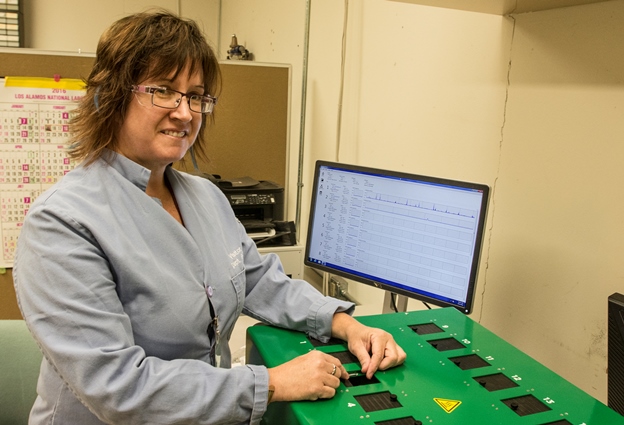
Pantex scientist Stephanie Steelman works with the SMSLS analysis instrument. Collaboration between Pantex and Tulane University developed a new method of analyzing polymers.
Steelman directs Pantex’s Gel Permeation Chromatography Lab (GPC). “GPC is used to monitor the molecular weight of the polymers in PBXs,” she said. “SMSLS allows us to determine which stressors cause polymers to degrade or fail on the molecular level when in solution, as well as determine when the polymers are in equilibrium for GPC testing.”
Steelman offered another car analogy to help explain the concept.
“The seats in a car eventually wear out. Wouldn’t it be nice to know when they’re going to wear out ahead of time? What would cause them to wear out? Then we’d know when to replace them,” she said.
When Steelman first learned about SMSLS, it was being used only in pharmaceutical and university settings. She thought it could be used at Pantex as well. The researchers at PolyRMC enthusiastically agreed and collaboration began in 2013, with funding from Plant Directed Research, Development, and Demonstration.
The SMSLS instrument takes light-scattering measurements at a rate of up to 10 data points per second to identify degradation of polymers in solution. The SMSLS data identified unique signatures for polymer degradation under temperature stressors. This information can be particularly useful in assessing performance of these polymers over time under different conditions and also build predictions about their stability over time at different temperatures.
“What I’m trying to do is build more quality into the process. SMSLS enhanced my ability to do my job, molecular weight analysis, in a much better fashion,” Steelman said. “If you don’t have the polymer in there doing its job, the explosive won’t do its job.”
After the collaboration project concluded in September 2015, the first commercial SMSLS instrument was located in the GPC Lab at Pantex. The device that scientists nicknamed “smi sls” (rhymes with missiles) bears serial no. 0001.
Alex W. Reed, associate director for Operations and Strategy at PolyRMC, said the roadmap for SMSLS initially did not include this type of polymer application.
“The collaboration with Pantex directly contributed to advancing the development and commercialization of the SMSLS technology,” Reed said. “The first SMSLS at Pantex also means that Pantex may provide some of the earliest new applications of value in the area of polymer stability and non-equilibrium processes.”
West Point cadets collaborate with Pantex
West Point. To hear or see the name, most people automatically think of honor and strength. It also makes sense that students of the U.S. Military Academy in New York would want to intern for a CNS site. This year, two West Point interns gained work experience at Pantex.
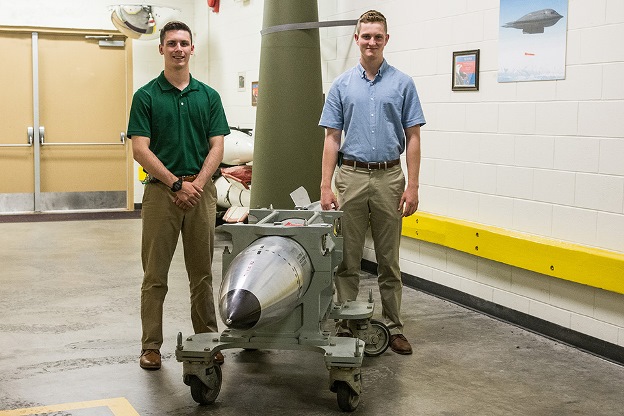
Michael Grieb (left) and Frederick Albion were Pantexans for a few months this summer as part of a Military Academy Collaboration.
“The West Point cadets we hosted, Michael Grieb and Frederick Albion, were part of a Military Academy Collaboration,” said Nate Davis of Pantex’s Engineering and Science. “Pantex typically hosts cadets as they have a nuclear engineering option in their program.”
While Davis is a first-time host to cadets, he came away with a sense of respect. “The ability of the cadets to go through military and engineering training concurrently gave me a renewed and strengthened appreciation for those who serve,” he said.
The Military Academy Collaboration’s purpose is to provide cadets “a first‑rate experience working cutting-edge research and development opportunities in disciplines and technologies of mutual interest to the Military/Service Academies, the Department of Defense, the Department of Homeland Security, the Department of Transportation, and to the NNSA [National Nuclear Security Administration].”
Ashley Stowe is Mission Engineering’s Intern Program lead. “It is always a privilege and honor to host West Point cadets. They bring a unique perspective to our work, and this internship allows cadets to see the manufacturing side of the nuclear arsenal.”
Davis said, “Having interns provides a great opportunity. It allows Pantex to show our customers how we work, and it’s also a potential recruitment tool.”
“This program gives us a great opportunity for collaborating with our customers in the DoD, and better allows them the chance to see firsthand the challenges Pantex faces in producing our product, as well as the chance to see our successes and technology advances,” Davis said.
Stowe said, “They are tomorrow’s leaders, and we provide a survey of our processes, procedures and overall role in the supply chain, so they are better equipped to make good decisions.”
The cadets were glad to be Pantexans for four weeks. Grieb said, “I think Pantex was a great experience. It certainly gave me an eye-opening to what future job opportunities could be in the nuclear enterprise.”
Albion was a fan too. “I’ve had a great time these past four weeks. It’s a great place to come to learn a whole lot.” More information about Military Academic Collaborations is available on the NNSA website.
Pantex supports emergency needs during train derailment
Brenda Vermillion, Carson County Emergency Management coordinator, said she first thought the June 28 head‑on collision between two BNSF trains was an incredibly loud test shot at the Pantex Plant, but she quickly realized the noise was located at the edge of Panhandle, Texas. “I immediately ran outside the building, and could see the cars toppling and then the explosion,” she said.
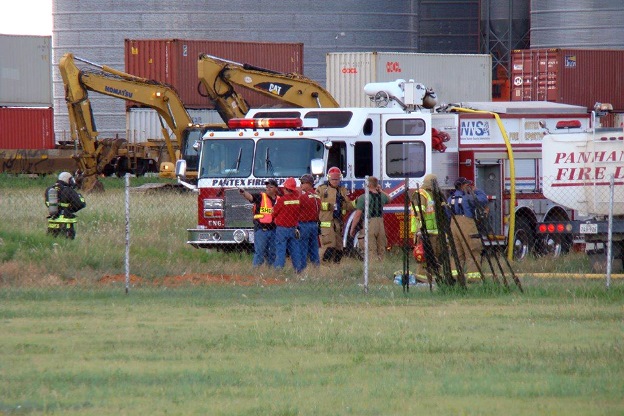
Several Pantex response vehicles that are a cross between a normal fire engine and an engine designed for a refinery fire respond to Panhandle train derailment. Photos taken by Shelly Zimmerman.
Vermillion went immediately to the dispatch office at the Carson County Law Enforcement Center. “We were already receiving 911 calls,” she said. “I told the dispatchers to call everyone and get everything you can.”
Pantex was one of the first calls. “The response from Pantex was fantastic,” Vermillion said.
Pantex dispatched one engine when the alarm sounded, said Mike Brock, Pantex fire chief. Fire department personnel then evaluated the situation and dispatched another truck as quickly as possible. The Pantex response vehicles are a cross between a normal engine found in a city like Amarillo and an engine designed for a refinery fire, Brock explained. Intended to be fed by a high‑pressure fire loop, Brock said the truck had water pumped to it so that it could blast hundreds of gallons a minute on the blaze. One truck, he said, was manned by Pantexans and ran continuously for about 48 hours.
Pantex has to maintain a level of readiness at all times. Brock said they called off‑shift personnel and set up a rotation schedule, which allowed firefighters to rest, clean up, eat and be ready to return if needed while maintaining the site’s requirements.
“Our guys operated flawlessly, and I could not be more proud of them,” said Brock.
Carson County Judge Dan Looten agreed, saying, “We stretched everyone to the limit, but Pantex ran very well while transferring people in and out.” Hundreds of first responders from across the Texas Panhandle were sent to the small town about 10 miles from Pantex.
Pantex also provided an Incident Command Vehicle that served as a command center on one side of the train. Looten explained the length of the trains made it difficult to quickly travel from one side to the other because the railroad crossings were blocked by rail cars. “We were managing two scenes — one on the north side and one on the south,” he said. Pantex’s ICV was vital to the response, he said.
Meanwhile, Vermillion, who was running the response from the county’s emergency operations center, received a call from Pantexan Chuck Rives, who was in the Pantex emergency operations center. Rives, a member of the Pantex Emergency Management Department and team lead for the Consequence Assessment Team, was able to work with Vermillion’s team to identify areas of concern in the trains’ manifests.
“Chuck was fantastic,” said Vermillion. “We couldn’t have done it without him. He stayed on the phone the entire time.” Rives quickly pointed to his co-workers — Brenda Graham, Sheryl Moran, Raj Sheth and Teri Vigil — who sorted through dozens of pages of the trains’ manifest to identify possible hazardous cargo, material properties and toxicity information. “Their work narrowed our focus to just a few dangerous cars so that I could quickly and accurately relay information to Brenda,” Rives said.
The team also provided smoke plume modeling working with the National Atmospheric Release Advisory Center. Knowing what the Panhandle winds were expected to do was vitally important, Vermillion and Looten said. Early in the day, portions of the town were evacuated because of smoke. If the winds changed, driving the fire farther down the train, other actions would be needed to keep the community safe.
Todd Ailes, Pantex site manager, praised the response efforts. He said, “This was a tragic accident that touched the lives of hundreds of our employees who live in Panhandle. Our concern was to help our neighbors in any way possible. Pantex Fire Department, Emergency Management and Communications & Public Affairs personnel worked diligently to provide any services needed by the town, and to provide accurate updates and safe route information to our employees who live in or travel through Panhandle.”
Brock conducted an after‑action review and identified some lessons, including improved interface between the agencies, different types of equipment that could be included on the trucks and the need for new communication equipment that will enable the Pantex team to hear and respond to the other teams.
“Unfortunately, when we get called to do what we are trained to do, it is someone else’s worst day,” said Brock.
Pantex Rescue Team: Ready to act
The Pantex Fire Department Rescue Team, along with Y-12 firefighter John Fife, who was visiting Pantex, recently participated in a Confined Space Training event in Panhandle. Members of the rescue team are trained in five disciplines—confined spaces, heavy vehicles, structures, rope and trench rescue.
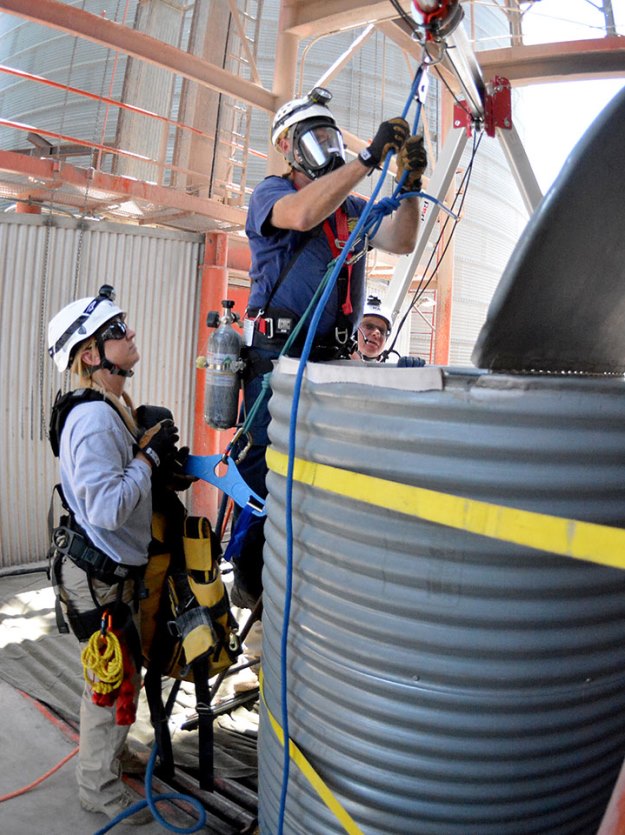
Pantex Fire Department Rescue Team members participate in a confined space training event in Panhandle, Texas.
“All of our team is highly trained,” said Lee Foster, Pantex Fire Department captain. “They have all been to specialized school throughout the tri-state area and are extremely skilled when it comes to these difficult rescue scenarios.”
The rescue team, made up of 23 members, has to train in the five disciplines annually. “We have to train in each area a minimum of eight hours each year,” Foster said. All of that training has been used as the team has been called upon for rescues in the Palo Duro Canyon area as well as other surrounding areas.
Pantexans send a piece of home to overseas military
Since 2002, Pantexans have sent more than 9,000 care boxes to U.S. military stationed overseas and are continuing the tradition—thanks to Consolidated Nuclear Security, LLC.
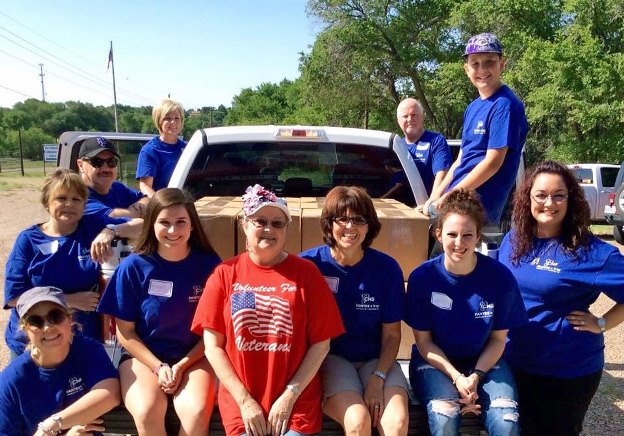
Packing day volunteers pose before heading to the post office with the boxes they prepared.
During the recent Pantex Day of Volunteering, Pantexans and their friends and family members teamed up with Veterans of Foreign Wars Post 430 to pack 28 care boxes. CNS contributed $2,000 to cover the shipping.
“Packing these boxes requires a lot of volunteers,” explained Verlene Dickson, retired U.S. Army member and director of the Veterans Resource Center in Amarillo. “There’s a lot that goes in to collecting the items that are donated, organizing the volunteers during a packing day and then getting these boxes shipped.”
Kimbel Leffew, a Pantexan who knows first-hand the importance of care boxes, offered to lead the team of volunteers during packing day.
“All of my children are or were in the military,” said Leffew. “I know how meaningful packages from home were to them, especially when some of the military receive absolutely nothing.”
In total, the volunteer team packed and shipped 28 boxes for 14 individuals in seven different United Service Organizations (USOs). Each recipient received two care boxes: one full of snacks such as chips, jerky, peanuts and even Girl Scout cookies; and the other loaded with an assortment of hygiene products such as deodorant, shampoo, lotion and hand sanitizer.
“When they open those boxes, they don’t just see the snacks, they see the love that is put behind these boxes, and that matters more to them than the actual contents of the box,” said Luan Martin, packing day facilitator and retired Pantexan. “It’s a piece of America.”
